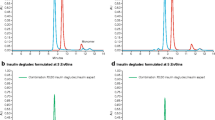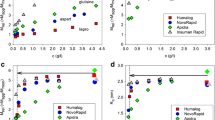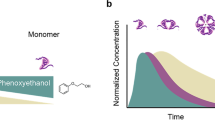Abstract
Purpose. To utilize an acylated peptide as a model system to investigate the relationships among solution peptide conformation, non-covalent self-association, subcutaneous absorption and bioavailability under pharmaceutically relevant solution formulation conditions.
Methods. CD spectroscopy, FTIR spectroscopy, equilibrium sedimentation, dynamic light scattering, and size exclusion chromatography were employed to characterize the effects of octanoylation on conformation and self-association of the 31 amino acid peptide derivative des-amino-histidine(7) arginine(26) human glucagon-like peptide (7-37)-OH (IP(7)R(26)GLP-1). Hyperglycemic clamp studies were performed to compare the bioavailability, pharmacokinetics, and pharmacodynamics of solution formulations of oct-IP(7)R(26)GLP-l administered subcutaneously to normal dogs.
Results. Octanoylation of IP(7)R(26)GLP-1 was shown to confer the propensity for a major solvent-induced conformational transition with an accompanying solvent- and temperature-dependent self-association behavior. Formulations were characterized that give rise to remarkably different pharmacodynamics and pharmacokinetics that correlate with distinct peptide conformational and self-association states. These states correspond to: (i) a minimally associated α-helical form (apparent molecular weight = 14 kDa), (ii) a highly associated, predominantly β-sheet form (effective molecular diameter 20 nm), and (iii) an unusually large, micelle-like soluble β-sheet aggregate (effective molecular diameter 50 nm).
Conclusions. Bioavailability and pharmacokinetics of a self-associating peptide can be influenced by aggregate size and the ease of disruption of the non-covalent intermolecular interactions at the subcutaneous site. Hydrophobic aggregation mediated by seemingly innocuous solution formulation conditions can have a dramatic effect on the subcutaneous bioavailability and pharmacokinetics of a therapeutic peptide and in the extreme, can totally preclude its absorption. A size exclusion chromatographic method is identified that distinguishes subcutaneously bioavailable aggregated oct-IP(7)R(26)GLP-1 from non-bioavailable aggregated oct-IP(7)R(26)GLP-1.
Similar content being viewed by others
REFERENCES
J. L. Cleland and R. Langer in Formulation and Delivery of Proteins and Peptides, American Chemical Society, Washington, D.C., 1994, pp 1–19.
M. C. Manning, J. E. Matsuura, B. S. Kendrick, J. D. Meyer, J. J. Dormish, M. Vrkljan, J. R. Ruth, J. F. Carpenter, and E. Shefter. Biotech. Bioeng. 48:506–512 (1995).
B. Chen, T. Arakawa, C. F. Morris, W. C. Kenny, C. M. Wells, and C. G. Pitt. Pharm. Res. 11:1581–1587 (1994).
D. N. Brems. Folding of bovine growth hormone. in Protein Folding: Deciphering the Second Half of the Genetic Code (eds. L. M. Gierash and J. King) 129–135, Washington, D. C., 1990).
J. London, C. Skrzynia, and M. E. Goldberg. Eur. J. Biochem. 47:409–415 (1974).
M. Gutniak, C. Orskov, J. J. Ahren, and B. Efendic. N. Engl. J. Med. (1992).
M. K. Gutniak, B. Linde, J. J. Holst, and S. Efendic. Diabetes Care 17:1039–1044 (1994).
M. Nauck. Diabetic Medicine 13:39–43 (1996).
P. J. Casey. Science 268:221–225 (1995).
D. Clodfelter, J. Reilly, and M. Nussbaum submitted for publication.
S. W. Provencher and J. Glockner. Biochemistry 20:33–37 (1981).
S. W. Provencher. CONTIN Users Manual. EMBL Technical Report DA05, European Molecular Biology Laboratory, Heidelberg, (1982).
H. K. Schachman. Utracentrifugation, Diffusion, and Viscometry, Academic Press, New York (1957).
D. K. McRorie and P. J. Voelker. Self-Associating Systems in the Analytical Ultracentrifuge, Beckman Instruments (1993).
H. Qi and D. L. Heller. J. Pharm. Sci. Tech. 49:289–293 (1995).
Y. Kim and C. A. Rose. Pharm. Res. 12:1284–1288 (1995).
W. W. Yau, J. J. Kirkland, and D. D. Bly in Modern Size Exclusion Chromatography. Wiley, New York (1979).
A. Dong, S. J. Prestrelski, S. D. Allison, and J. F. Carpenter. J. Pharm. Sci. 84:415–424 (1995).
Y. Takakura, M. Hashida, and H. Sezaki. Lymphatic transport after parenteral drug administration. In W. N. Charman and V. J. Stella (eds.) Lymphatic Transport of Drugs CRC Press, Boca Raton (1992) 255–277.
W. Parker and P.-S. Song. Biophys. J. 61:1435–1439 (1992).
J. Johansson, G. Nilsson, R. Stromberg, B. Robertson, H. Jornvall, and T. Curstedt. Biochem. J. 307:535–541 (1995).
M. M. E. Snel, R. Kapstein, and B. Kruijff. Biochemistry 33:3387 (1991).
C. Tanford. The Hydrophobic Effect, John Wiley and Sons, New York (1980) 139–145.
K. Thornton and D. G. Gorenstein. Biochemistry 33:3532–3539 (1994).
W. Yonemoto, M. L. McGlone, and S. S. Taylor. J. Biol. Chem. 268:2348–2352 (1993).
K. W. Traxler and T. G. Dewey. Biochemistry 33:1718–1723 (1994).
M. Joseph and R. Nagaraj. J. Biol. Chem 19439–19445 (1995).
G. James and E. N. Olson. Biochemistry 29:2623–2634 (1990).
J. Zuidema, F. Kadir, H. A. C. Titulaer, and C. Oussoren. Int. J. Pharmaceutics 105:189–207 (1994).
H. R. Constantino, R. Langer, and A. M. Klubanov. J. Pharm. Sci. 83:1662–1669 (1994).
J. Heller. Use of Poly(ortho esters) and polyanhydrides in the development of peptide and protein delivery systems. In J. L. Cleland, and R. Langer (eds.) Formulation and Delivery of Proteins and Peptides, American Chemical Society, Washington DC (1994) 292–305.
Z. Gao, A. J. Shukla, J. R. Johnson, and W. R. Crowley. Pharm. Res. 12:857–863 (1995).
J. Brange, U. Ribel, J. F. Hansen, G. Dodson, M. T. Hansen, S. Havelund, S. G. Melberg, F. Norris, K. Norris, L. Snel, A. R. Sorensen, and H. O. Voigt. Nature 333:679–682 (1988).
J. Brange, D. R. Owens, S. Kang, and A. Volund. Diabetes Care 13:923–954 (1990).
D. L. Bakaysa, J. Radziuk, H. A. Havel, M. L. Brader, S. Li, S. W. Dodd, J. M. Beals, A. H. Pekar, and D. N. Brems. Protein Science 5:2521–2531 (1996).
Author information
Authors and Affiliations
Rights and permissions
About this article
Cite this article
Clodfelter, D.K., Pekar, A.H., Rebhun, D.M. et al. Effects of Non-Covalent Self-Association on the Subcutaneous Absorption of a Therapeutic Peptide. Pharm Res 15, 254–262 (1998). https://doi.org/10.1023/A:1011918719017
Issue Date:
DOI: https://doi.org/10.1023/A:1011918719017




